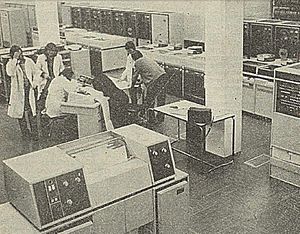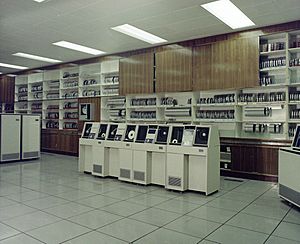English Electric System 4 facts for kids
The ICL System 4 was a large computer, known as a mainframe, first announced in 1965. It was made by a company called English Electric, which later became ICL. This computer was designed based on ideas from other computer systems, like the RCA Spectra 70 and IBM System 360.
Contents
Different Models
The ICL System 4 came in several different versions. Each version had slightly different features and speeds.
Early Models
Some of the first models included:
- The System 4-10, which was meant to be a smaller, helper computer. However, not many people wanted it, so it was stopped.
- The System 4-30, introduced in 1967. It was supposed to be very popular, but it wasn't powerful enough and was later removed.
- The System 4-40, which was a slower version of the 4-50. It was made when the 4-30 didn't work out as planned.
Popular Models
The most successful models were the System 4-50 (from 1967) and the System 4-70 (from 1968). These were followed by improved versions, the 4-52 and 4-72. A special, slightly slower version called the 4-62 was even sold in Eastern Europe.
How the Computer Worked
The System 4-50 and 4-70 were designed to handle many tasks at once, especially for "real-time" jobs. Real-time means the computer responds instantly, like for controlling machines or processing live data.
Processor States
These computers had a special way of working called "processor states." Think of it like the computer having different "modes" for different types of work. There were four main states:
- User State (P1): This was for regular programs that people ran.
- Interrupt Response State (P2): This state handled quick responses when something important happened, like a printer running out of paper.
- Interrupt Control State (P3): This state decided what to do after an interrupt happened.
- Emergency State (P4): This was the highest state. It kicked in during serious problems, like a power cut. If the power went out, the computer would quickly save important information before shutting down safely. This happened in less than one millisecond!
Each state had its own set of "registers." Registers are like tiny, super-fast storage areas inside the computer's processor. Having separate registers for each state helped the computer switch between tasks very quickly without losing information.
Computer Speed
Computers measure speed in microseconds (millionths of a second). The System 4-70 was much faster than the 4-50 for many operations. For example:
- Adding two numbers took about 8.88 microseconds on the 4-50, but only 2.1 microseconds on the 4-70.
- Multiplying numbers was also much faster on the 4-70.
Connecting Devices
The ICL System 4 could connect to many different "peripheral devices." These are pieces of equipment that help the computer get information in and out.
Card Readers
The computer could read information from punched cards. These were cards with holes punched in them to represent data.
- It could read 80-column cards (a common size) at speeds of 800 to 1,435 cards per minute.
- It could also read 51-column cards even faster, at up to 1,820 cards per minute.
Other Devices
- Paper Tape Readers: These read information from paper tapes with holes, at 1,500 characters per second.
- Paper Tape Punches: These created new paper tapes, punching 150 characters per second.
- Card Punches: These created new punched cards, punching 100 cards per minute.
- Magnetic Tape Units: The computer could connect to up to eight magnetic tape units. These were like large cassette tapes used for storing lots of data. Different models had different tape speeds.
- Magnetic Discs: These were like early hard drives. They could store millions of bytes of data and transfer information quickly.
Printing
The System 4 could use different types of printers.
- Medium-speed printers could print around 600 lines per minute.
- High-speed printers were much faster, printing up to 1,150 lines per minute.
- If a printer had a special drum with only 16 characters, it could print incredibly fast, at 2,700 lines per minute!
Operating System
The computer used an "operating system" that could run many programs at the same time. This is called "multi-programming." At first, the system had some issues with how it handled data going in and out. But around 1971, ICL improved it. They made changes so the computer could process data more efficiently, which made it work much better.
Real-World Uses
The ICL System 4 was very good at communicating with other systems. This made it useful for "real-time processing," where quick responses were important.
EMAS and Interact 75
- One System 4-75 computer was used at the ERCC to help create a new interactive operating system called EMAS. This system allowed many users to work on the computer at the same time.
- Another System 4-75 was used to develop a business software package called "Interact 75." This software was for things like payroll and financial records, but it wasn't very successful and the project was eventually stopped.



